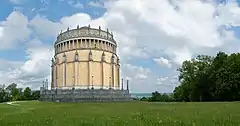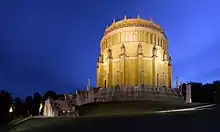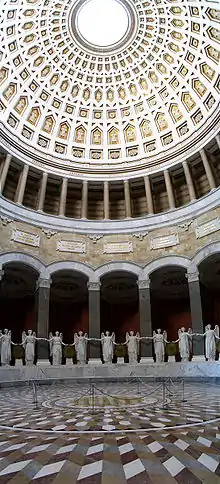Befreiungshalle
The Befreiungshalle ("Hall of Liberation", German: [bəˈfʀaɪ̯ʊŋsˌhalə]) is a neoclassical monument on the Michelsberg hill above the town of Kelheim in Bavaria, Germany. It stands upstream of Regensburg on the river Danube at the confluence of the Danube and the Altmühl, i.e. the Rhine–Main–Danube Canal. It is just downstream of the Danube Gorge, towering above its lower end. It was commissioned by King Ludwig I of Bavaria to commemorate the victory over Napoleon in the Befreiungskriege of 1813–1815.
| Befreiungshalle | |
|---|---|
 Befreiungshalle Kelheim | |
 Befreiungshalle Location in Germany | |
| General information | |
| Architectural style | Neoclassical |
| Town or city | Kelheim |
| Country | Germany |
| Coordinates | 48°55′06″N 11°51′38″E |
| Client | King Ludwig I of Bavaria |
| Owner | Bavarian Administration of State-Owned Palaces, Gardens and Lakes |
| Design and construction | |
| Architect | Friedrich von Gärtner, Leo von Klenze |
| Designations | Baudenkmal (listed monument) |
History



King Ludwig I of Bavaria ordered the Befreiungshalle to be built in order to commemorate the victories against Napoleon during the Wars of Liberation that lasted from 1813 to 1815.
The construction was started in 1842 by Friedrich von Gärtner in a mixture of Neoclassical and Christian styles. It occurred on Michelsberg, in a place previously occupied by a part of the ruins of a pre-historic fortification or town, thought by some to have been Alcimoennis. At the behest of the King, Leo von Klenze later altered the plans and completed the building in 1863. The ceremonial opening took place on 18 October 1863 – the 50th anniversary of the Battle of Nations (Völkerschlacht) near Leipzig.
The following dictum by King Ludwig I, embedded into the marble floor, commemorates the occasion of the construction of the Befreiungshalle:
- MOECHTEN
- DIE TEUTSCHEN
- NIE VERGESSEN WAS
- DEN BEFREIUNGSKAMPF
- NOTHWENDIG MACHTE
- UND WODURCH SIE
- GESIEGT.
- (May
- the Germans
- never forget what
- made necessary
- the Struggle for Freedom
- and by what means they
- won.)
This inscription of dedication is to be found above the ornamented door frame of the entrance portal:
- DEN TEUTSCHEN
- BEFREIUNGSKAEMPFERN
- LUDWIG I
- KOENIG VON BAYERN
- (To the German
- Liberation Fighters
- Ludwig I
- King of Bavaria)
For the celebration of the first stone laying on 19 October Ludwig I had written a poem dedicated to the soldiers who had fought in the Napoleonic Wars. Joseph Hartmann Stutz had set it to music:[1]
| German | English |
|---|---|
1. Heil Euch, wack’re Männer, muth’ge Krieger, |
1. Hail to you, valiant men, brave warriors |
2. Dumpf und finster hatt es uns umgeben, |
2. We were surrounded by dull and dark forces, |
3. Dass die Zwietracht schmählich uns gekettet, |
3. We will never forget |
4. Durch der Zeiten weite Ferne schlinge |
4. May forever wind |
Today
The hall is open to the public. The upper exterior gallery is closed to visitors.[2]
See also
- Völkerschlachtdenkmal (Monument to the Battle of the Nations, Leipzig, Germany)
- Walhalla temple (Hall of the Slain, Regensburg, Germany)
- Ruhmeshalle (Hall of Fame, Munich, Germany)
- Heldenberg Memorial (in Austria)
- Prussian National Monument for the Liberation Wars, Berlin, Germany
References
- The song on the website of the Bavarian administration for public castles, gardens and lakes.
- Aniol, Bayerische Verwaltung der staatlichen Schlösser, Gärten und Seen, Thomas. "Bavarian Palace Department - Palaces - Hall of Liberation at Kelheim". Retrieved 30 April 2017.
External links
| Wikimedia Commons has media related to Befreiungshalle. |
- Official Website
- Befreiungshalle – Photos
